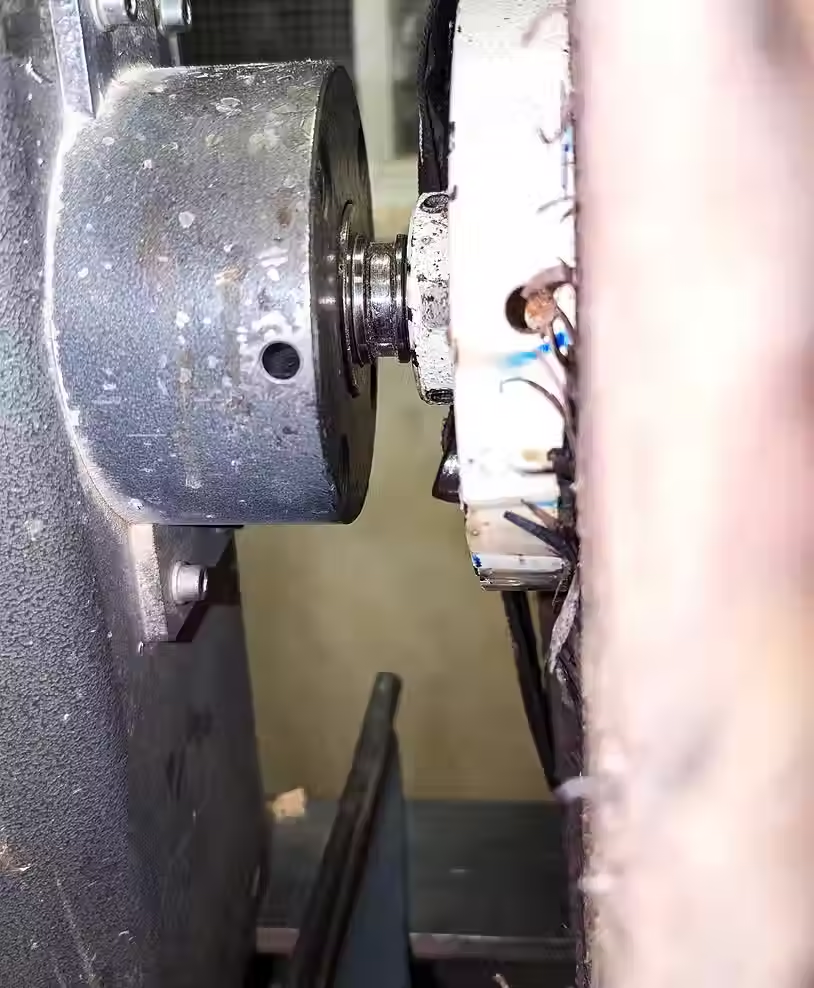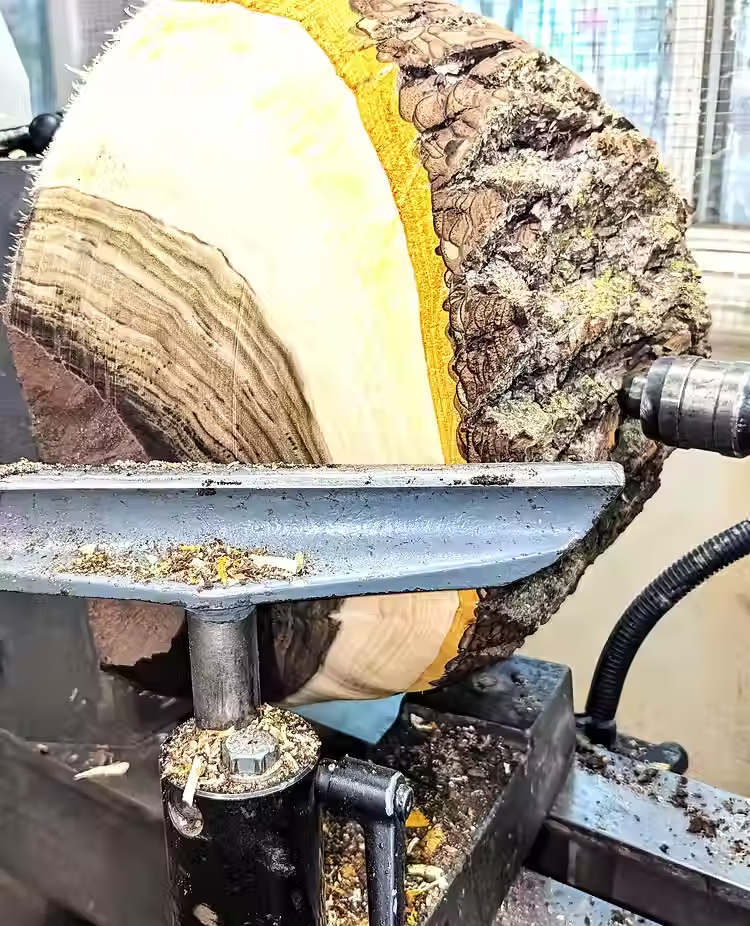How to Choose Wood for Woodturning
- Karen Escabarte
- Sep 29
- 6 min read
To be able to turn wood into various artforms, one must have a source of wood. Here, we will explore various strategies for obtaining wood without breaking the bank. We will discuss sources of wood for both spindle and bowl turning.
Spindle Turning. Spindle turning involves orienting a piece of wood on the lathe with the wood grain running parallel to the bed of the lathe. Usually, these wood pieces are not large in diameter (usually a few inches or less) and can be as long as the lathe can accommodate. Therefore, tree branches are a good source of wood for spindle turning.
At the ends of a section of a branch, there will be a small hole or indentation, at the center of the grain called the pith. The pith may or may not be in the center of the branch diameter. Usually, one begins spindle turning point-to-point using a drive center in the lathe headstock and a live center in the tailstock. When mounting the branch, one should avoid using the pith as the point of entry for the drive center or live center points. If the pith is central, mount the wood a short distance from the pith.
One begins turning by ‘rounding’ the piece, usually starting with a spindle roughing gouge, removing bark and making the wood piece symmetrical in shape. If the branch chosen for turning is still wet, one can turn the piece wet orputting it away to dry. If drying is to be done inside at room temperature, then leave the bark in place and put the wood inside some sort of wrapping. I use plastic bags. Every few days, turn the plastic bag inside out. You will be amazed about how much moisture is on the new outside of the bag. The ends of the wood piece will tend to crack. An option to deal with this is to seal the ends with a waxy emulsion, available commercially. In my opinion this is not necessary, just let the piece dry and if the ends are cracked, just cut off the ends to eliminate the cracks. Of course, wood for spindle turning can be purchased at hobby stores or from lumber yards. Klim dried wood needs no further processing before using, but one pays for this convenience. Wood obtained ‘in the wild’ needs to be dried, either before or following the turning process.
Bowl Turning. Wood pieces used for bowl, or for larger wood art productions, are usually greater in diameter than pieces used for spindle turning. Because of their size, these pieces purchased commercially end up being quite expensive. Therefore, most turners acquire their bowl turning blanks from felled trees on their property, along the road, from friends or from tree trimmers. If one carries a chain saw in their vehicle, valuable logs can be found along a road, just waiting to be harvested by an energetic wood turner. Usually, logs are cut into sections, as long as the diameter of the log. Then, the piece is halved parallel to the direction of the grain.
This piece can be turned wet or dried gradually in plastic bags as described above for spindle turning blanks. Another option is to turn the bowl wet, but leave it thicker than the finished bowl would be. For a 12” diameter bowl, one would leave the turning 1/2 to 1” thick prior t o drying. The purpose of this two-step bowl turning is to prevent the final turned bowl from distorting. Looking at the bowl rim of a wet turned bowl after a few days, the end grain section will elevate, and the bowl will become oblong to some extent. Some turners like this distorted look, but others prefer a more symmetrical finished shape to their bowl.
The rough turned bowl can be placed in the plastic bag rotations described above. However, it may take months for this bowl blank to dry completely. Preventing cracking is the primary purpose for slow drying of a bowl blank. Left exposed to the air, even while turning, the bowl blank will tend to crack. Usually, once the bowl is turned to an even thickness, it will not crack, unless it is wet. Cracks are the nemesis of the bowl turner. If cracks do occur, they can be filled with colorful epoxy to create a design or filled with wood chips (although sanding ‘dust’ is better) and super glue.I hope this discussion on spindle and bowl blank preparations are helpful to the inspiring woodturner.

Choice of Wood. When I have a potential project in mind (lets say a bowl), the first step is to choose the appropriate wood species and wood condition. If I have in mind to make a large salad bowl, I will select a rather large piece of wood from my wood pile. It may be rather rough looking with some cracking on the edges.
If I want to make a more refined, smaller bowl or platter/plate, I will select a turning blank that has been kilim dried. If I want to make an urn, I will select the appropriately sized piece of dry wood. Wall hangings require a larger blank – usually a piece that is a slice through the tree trunk, sliced parallel to the ground. This piece may be 24 to 30 inches in diameter and be considerably heavy.

Preparing the turning blank for the lathe. If the wood blank in my wood pile is rather large, I will use a dolly to move the blank into the shop.
If it is a heavy piece, either because it is freshly cut and very wet inside or because it’s large, I will have to use a motor hoist to lift onto the bandsaw table. Next, I will remove any branch buds with the bandsaw and inspect the piece for cracks, nails or other defects that would make the piece unacceptable for turning.
A large salad bowl blank will be 12 – 18 inches in diameter. It is cut so that I am working with ½ of a log, sliced down the middle (In orientation to a standing tree, a turning blank is cut parallel to the ground and then halved vertically to the ground, See Picture above). A faceplate is centered to the flat plane of the blank and secured with wood screws.


Mounting the turning blank onto the lathe. The turning blank is moved from the bandsaw table to the lathe by hand, or if heavy with the motor hoist. The treaded faceplate is screwed onto the lathe spindle.
The tailstock is moved to the opposite face of the wood piece. The turning blank is now in position for turning.
Standing aside, the lathe speed is gradually increased to a safe turning speed. One stands aside, as bark can fly off the piece with the centrifugal force generated by the lathe spinning. Now, the blank is ready for turning.
Shaping the bowl exterior. Using a 5/8 inch diameter bowl gouge, I begin roughing out the bowl. This process is rather “bumpy” as the wood piece is not completely round to begin with.
Once rounded, the turning becomes much smoother. The bark side of the turning blank dictates the outside bowl shape to a large degree. If the bark side of the blank is nice and round (as you are facing a tree – is it truly round or somewhat indented as you walk around the tree?). If the portion of the blank near the tailstock is somewhat indented, then the bowl surface will have to follow this shape and be turned with a indented shape called an ogee.


The turning is continued, modifying the shape and the surface texture. In the picture above one is able to see all the layers of the tree. From the bark inward there is the cambion layer (yellowish color), the sapwood (white) and the heartwood (dark).
The cambion carries nutrients and produces new wood and bark, the flexible sapwood transports water and minerals, and the heartwood provides stability to the tree being composed of multiple vertically-oriented cellulose tubes or straws. Care is taken turn the surface as smooth as possible, as this reduces the amount of sanding required. The final turned outside surface is shown in the picture below.
The squarish appearing component on the bottom of the bowl blank is called the tenon and will be used to attach the bowl blank to a chuck for turning the inside of the bowl (future discussion).
As can be seen, the bark has all been removed and only a small strip of the cambion remains. The streaks and tool marks seen in the heartwood will be removed with sanding.
This description explains the processes used to prepare a bowl blank for turning and the turning of the bowl exterior surface. A future writing will explain the process of turning the bowl inside.




Comments